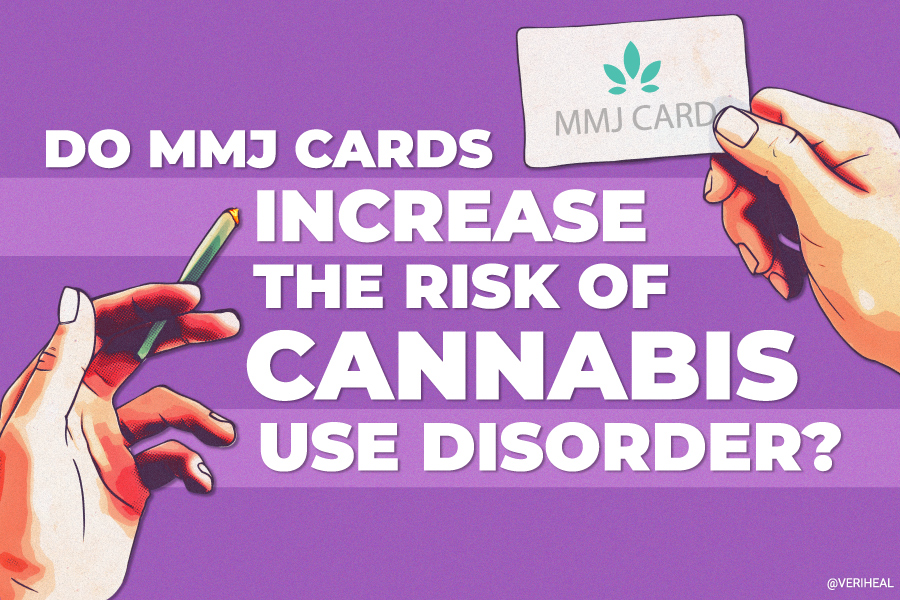Cannabis use disorder (CUD) is often confused with frequent cannabis use, but CUD is significantly more worrisome. A recent study, funded by the National Institute on Drug Abuse (NIDA) and published in JAMA Network Open, reported a correlation between obtaining a medical marijuana (MMJ) card and developing CUD. The study looked into the effects of owning an MMJ card and has raised many eyebrows, but probably not for the reasons you think. Despite being published in a reputable journal, there are questions about the legitimacy of the research.
Investigating the Impact of MMJ Cards
The study was conducted by more than 10 researchers, with leads Dr. Jodi Gilman and Dr. Kevin Potter taking responsibility for the integrity and accuracy of the data. The team sought to answer the following: “What are the risks and benefits of obtaining a medical marijuana card for adults who seek medical marijuana for pain, insomnia and anxiety or depressive symptoms?”—a necessary question to address as medical marijuana becomes more accessible.
According to the report, 186 participants were included in this randomized clinical trial, which ultimately concluded that “Immediate acquisition of a medical marijuana card increased the incidence and severity of cannabis use disorder (CUD) and resulted in no significant improvement in pain, anxiety, or depressive symptoms but improve self-reported sleep quality.” The outcomes and measures used throughout the trial included changes in CUD symptoms; anxiety and depressive symptoms; pain severity; and insomnia symptoms.
The importance of the research is based on the fact that there is no “strong clinical literature” to support the widespread use of cannabis products for a variety of conditions, and that the effects of owning an MMJ card are “largely unknown.” The team focused its efforts on understanding whether owning an MMJ card impacted CUD, particularly in terms of chronic pain, insomnia, anxiety, or depressive symptoms.
The researchers split their participants into two groups with a ratio of 2:1. The two groups were “immediate card acquisition” (105 participants) and “delayed card acquisition” (81 participants). This means those in the first group were able to obtain their MMJ card immediately after the randomized group placement, while the second group waited 12 weeks before obtaining theirs. After obtaining their cards, all participants could choose their own products, dosages, and frequency of use.
On its face, the study appears sound, but the associated report includes language that raises concerns about the researchers’ methods and analysis. If having an MMJ card has adverse impacts on consumption, the public has a right to know; at the same time, the convoluted nature of the research makes it very easy to misinterpret and misunderstand the findings. So, why are people concerned about this particular CUD study? Let’s take a closer look.
Science or Bias?
Besides the fact that it is challenging to see how MMJ cards are correlated with CUD—beyond the expected increase in consumption that comes with having the card—there are other questionable statements being made in the report.
Clinical Trial Sample Size
The trial was conducted with just 186 participants, which is far too small of a sample size to provide findings generalizable to the larger population. The National Library of Medicine explains that the number of subjects in a study is “a critical component” and that an adequate number of participants “are needed in order to be able to answer the research question of interest with a degree of certainty.”
Additionally, when research with such a small number of participants is being used to represent roughly 147 million people (cannabis consumers worldwide), the power of the study reduces significantly while the margin of error increases. The CheckMarket sample size calculator relays that if one wants to properly represent 147 million people, the sample size should be around 2,401 participants. In addition, medical studies also need to be replicated over time to confirm findings.
Understanding of CUD
The researchers do not clearly establish a definition for CUD alongside their statement that “The most commonly reported CUD symptoms were higher tolerance and continued use despite the recurrent physical or psychological problems caused or exacerbated by cannabis.” This may be intentionally vague, as “higher tolerance” and “continued use” are hardly symptoms of CUD and are more accurately defined as criteria that underpin the diagnosis of having CUD.
Symptoms of CUD include the likes of having an inability to control the desire to consume, risk-taking in order to consume, agitation, irritability, paranoia, and self-isolation, among others. The participants at most had only two recorded symptoms out of the possible 12. The difference between what underpins, or causes, CUD and its symptoms is the fact that higher tolerance and continued use can potentially lead to the development of CUD, while the symptoms are an indication of actually having CUD.
Missing Information
While lengthy, there is a surprising amount of missing information in the study. For starters, the researchers did not specify what kind, quality, or amount of cannabis was being consumed nor in what form. As Dr. Claude Cyr pointed out in the comments, the aforementioned information on cannabis is important “since cannabis has abuse potential” and considering the fact that CUD “is likely dose dependant.”
The researchers explained that medical cards were obtained and, for all we know, the participants could have been consuming high-potency tetrahydrocannabinol (THC)—which has been linked to more adverse effects such as elevated risk of psychosis and increased anxiety.
Since the study did not pay for, arrange, or regulate the acquisition of MMJ cards and cannabis products, there is no way to know what, how much, or how often the participants were consuming, as well as how those factors played into the findings. The study also said that the participants could continue their usual treatments or psychiatric care but did not specify which conditions the patients had.
Daily Cannabis Use as a Disqualifier
Numerous factors excluded potential participants from joining the study, including daily cannabis use and CUD diagnosis at screening or baseline. The fact that daily use was a disqualifier means that participants would naturally be more susceptible to intense cannabis experiences due to low tolerances, which could explain why over three-quarters of the participants experienced some kind of “adverse event.” Ideally, cannabis use is increased slowly until desired health effects are achieved in order to minimize side effects.
CUD, according to the fifth edition of the Diagnostic and Statistical Manual of Mental Disorders (DSM-5), means that consumers have a higher tolerance to cannabis, have repeatedly tried to quit, spend a lot of time consuming cannabis, and even give up activities for cannabis consumption. However, the study found that “the immediate card acquisition group reported a greater number of CUD symptoms over the 12-week trial,” which is hardly enough time to determine whether they meet DSM-5 diagnostic criteria for CUD.
Various Limitations
As with any study, this one listed some limitations. The researchers stated that they “followed expert consensus guidelines by using timeline follow-back methods to document the frequency of use, rather than quantity or potency, of cannabis, supplemented with sensitive assays of urine cannabinoids.” However, baseline frequency rates are not provided, making “higher” frequency a null measurement.
They also stated that there was a high dropout rate in the immediate card acquisition group between the randomization and baseline stages. They were all too happy to state that it is reflective of “the cost and administrative burden of obtaining a medical marijuana card” but conveniently neglected to include how many dropped out.
Lastly, the researchers state that there is “inconclusive evidence of its [cannabis’] efficacy” in terms of being used medically but firmly point out that cannabis has been “associated with psychotic and depressive disorders, mania, suicide and cognitive impairment.” While it can’t be said with certainty whether personal biases were involved in these statements, failing to acknowledge the growing pile of positive evidence surrounding medical cannabis points to a potential conflict of interest.
Does the Data Justify the Conclusions?
In the “Sample Size and Power”’ section of the study, the team explains that 20% of the participants in the immediate card acquisition group developed CUD, while 5% of the delayed card acquisition group developed CUD. Even if we were to ignore the fact that the sample size is too small, the reported results of the relationship between MMJ card acquisition, increased consumption, and development of CUD are still insignificant.
In the “Outcomes” section, the researchers state that “there was no significant group effect on pain, anxiety or depression symptom ratings,” yet in their “Main Outcomes and Measures” section, they state that “Primary outcomes were changes in CUD symptoms, anxiety, depressive symptoms, pain severity and insomnia symptoms during the trial.” Discrepancies like this throughout the report lead us to believe the information laid out does not sufficiently justify the associated conclusions.
Additionally, the study stated that “those with a primary insomnia concern were unlikely to develop CUD, suggesting a potential clinical utility of cannabinoids for insomnia.” This indicates that they found cannabis to have a therapeutic effect on insomnia, but it’s not made clear how insomnia differs from other conditions in a way that puts those patients at a lower risk of developing CUD. Ultimately, the study’s report illuminates too many loose ends, and much more research is needed in this area in order to start developing sound conclusions.
Final Thoughts on MMJ Cards and CUD
CUD is often used as a means to argue that cannabis is addictive. While CUD does impact certain cannabis users and should be taken seriously, the severity of CUD hardly comes close to that of dependencies on substances such as tobacco and alcohol. Although holding an MMJ card can always put patients at risk for overconsumption, this study’s researchers failed to acknowledge the safe and reliable access to plant medicine that MMJ cards provide for patients with a variety of chronic illnesses.
We’ll never know for certain whether this article was intentionally designed to scare potential MMJ patients away. What we do know is that researchers and publishing houses need to be more thorough when it comes to releasing vetted information to the public. Next time you come across a study with concerning, bold claims like this one, take a closer look at the evidence—there may be more to it than meets the eye.
Author, Share & Comments
















